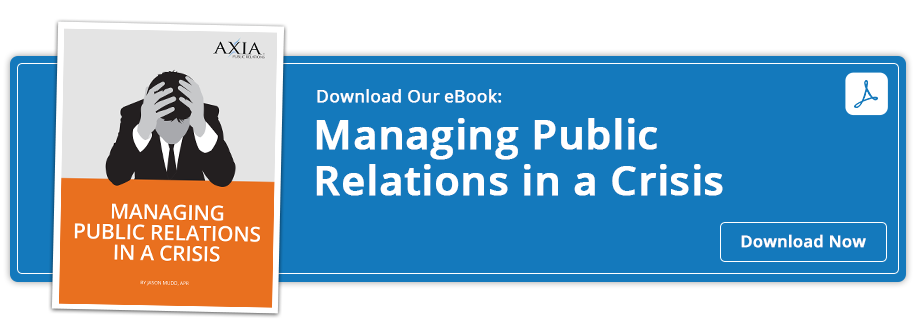11 crisis management tactics to avoid or prepare for a PR disaster
By Jessica McNellisNovember 29, 2023
Follow these best practices to ensure your company has a plan before a crisis strikes.
 The biggest challenge when creating an action plan for a media crisis is not knowing where it will come from. Crisis communications planning always seems to fall to the bottom of the to-do list until it’s suddenly urgent. If your company waits until the moment of disaster, you’re already 10 steps behind.
The biggest challenge when creating an action plan for a media crisis is not knowing where it will come from. Crisis communications planning always seems to fall to the bottom of the to-do list until it’s suddenly urgent. If your company waits until the moment of disaster, you’re already 10 steps behind.
Audio: Listen to this article.
To plan for the unforeseeable media crisis, follow our best practices to help your company succeed.
Identifying a media crisis
Knowing when your company is in a crisis — and when you’re not — can be difficult to determine. Reacting to a negative situation can unnecessarily escalate a potential crisis instead of naturally fizzling out. First, it’s important to learn when moments warrant a company response.
When faced with a potential crisis, ask yourself these questions:
- Is there a safety risk to the community?
- Does the situation damage your brand or reputation in the eyes of your audience?
- Will there be a significant financial impact?
If the answer is yes to any of those three questions, there is a strong chance this situation qualifies as a media crisis.
Here are some examples that would constitute a crisis:
- Product recall
- Damaging data released
- Scandal involving an employee or former employee
- Actual or presumed financial loss impacting your stakeholders
What might not constitute a crisis includes:
- One-off social media criticism (responding to a post otherwise ignored by your audience in an emotional way that can amplify the post to your followers)
- A negative online review
- Negative news surrounding a competitor
If you should find yourself in the wake of a media crisis, you need to plan your response.
Responding to a media crisis
There are five steps you should follow to plan your media response.
- Explore: Observe and gather context around the situation. Ensure you have all the information and data before formalizing a detailed response.
- Assemble: Gather your team and pull in all necessary parties involved in the crisis response.
- Plan: Develop a comprehensive plan and timeline for your crisis response.
- Execute: Put that plan into action.
- Reassess: Reevaluate at the end of the timeline and decide whether any further action or monitoring of the situation is needed.
In every crisis response plan, you should additionally include three necessary elements.
First, establish one spokesperson — a PR professional or person of authority for the given situation with media training — to address the issue publicly. Ensure contact information is easily accessible to the public and media to avoid someone other than the spokesperson addressing inquiries and muddying the message externally.
Second, establish a media plan including consistent messaging and statements, responses to all questions you anticipate getting asked (especially the hard questions), and how you will share those statements across mediums, from traditional media to social media and public events.
Finally, tailor messaging for all of your audiences. The degree of detail you share with your customers or the public might differ from the messaging you share with your stakeholders and employees.
Developing these materials ahead of your response will prevent crises from escalating unnecessarily.
How to avoid a crisis
In a perfect world, you can sidestep every crisis before it amplifies. While it’s not possible for every media crisis, you can avoid many situations with a little due diligence.
Here are three easy steps to avoid the preventable:
1. Anticipate where a crisis might come from.
Understand your areas of risk and see where your competitors have come under fire. Prepare holding statements for every situation that comes to mind, however improbable, so you’re not starting from scratch should it ever arise.
2. Audit your social media pages and web presence.
Google yourself! Many crises we see in headlines today stem from old comments in the media saved online and tweets from the early 2000s we’ve long forgotten about. Know what happens when someone Googles your name so you’re ready to address it. Scrub your social channels and recommend your employees do the same.
3. Require media training.
Make sure to train your spokespeople to communicate with the media. Practice interview tactics and understand the difference between on-the-record, on-background, and off-the-record. Research all reporters before you talk to them to better understand their writing style and any potential landmines.
If you’re interested in building a crisis communications plan for your company or setting up a media training session, book a one-on-one consultation with us to stay ahead of the curve.
Photo by Tima Miroshnichenko
Topics: PR tips, crisis communications


Comment on This Article